Most founders want to expand their TAM. By going upmarket, you can land bigger deals with more opportunities to upsell and lower churn. All of these components will ultimately drive your valuation. As Managing Director of Salesforce Ventures, Nowi Kallen, shared at last week’s Workshop Wednesday, there are five main challenges of moving upmarket and tips to follow if you want to succeed at Enterprise sales in today’s macro environment.
Let’s look at the why, the when, and a warning.
We’ve already mentioned the why. Most companies go upmarket to expand their TAM, land bigger deals, and find more opportunities. Going upmarket drives category leadership because you establish yourself as the company that the Fortune 500 logos use.
When? People start with the push to go upmarket vs. being pulled upmarket. It’s important to create conditions to get pulled upmarket.
The warning — You have to be patient. It won’t be an overnight success, and you’ll likely experience failures. You don’t want to end up in The Valley of Death, where you can’t get the big dollar contracts.
Salesforce Ventures interviewed several sales leaders in the space — Gong, Miro, Monday, Okta, and Wiz — to get an informed perspective on the challenges and lessons learned moving upmarket.
Challenge #1: Starting with Product-Led Growth and Deciding If It’s Worth It
If you start with PLG and want to move your customer base and prospects to Enterprise deals, you might ask yourself: Should I go for it?
For many, moving upmarket makes sense to scale. The solution for this challenge?
Show and deliver business value upfront.
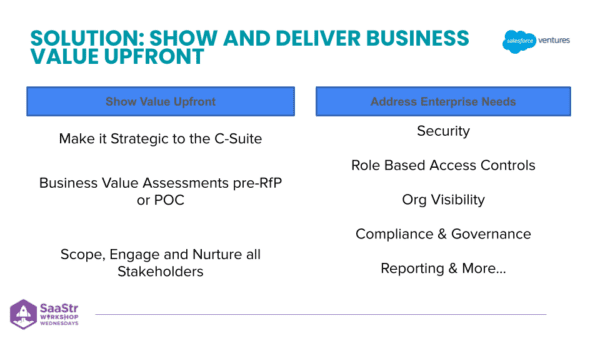
You have to expand your focus on how you sell and make it strategic to the C-suite. That means going higher in the organization to get buy-in and cultivate those relationships. With that comes business value assessments, where you put some numbers to the pitch in terms of ROI and the value it can bring your prospect.
You have to start early with the value you’ll bring and use that to shape an RFP. The one thing founders don’t do early enough is scope, engage, and nurture all stakeholders involved, not just the economic buyer or technical champion but the broader organization.
When you get to the phase of wanting to sell to Enterprise, it often breaks down at Enterprise needs.
- Security — SOC 2 compliance is table stakes.
- Role-based access controls
- Org visibility of how to manage the entire organization on the platform
- Compliance and governance
- Reporting
If you’re committed to the journey, build this into your platform early.
Challenge #2: Getting Your Enterprise Sales Organization Focused on the Right Deals and Selling the Right Way
As you drive PLG and want to move to Enterprise sales, how do you get your Enterprise sales organization focused on the right prospects and deals and sell the right way?
Let’s look at Miro as an example. Miro was trying to make the shift to more of a hybrid GTM. They said, “The growth is amazing, but we’ll have to be able to sell into the Enterprise. How do we do that if we’re busy enough driving PLG and it’s going well?”
The sales organization said that without the buy-in, commitment, and clarity provided by the C-suite, it wouldn’t work. A cultural shift starts at the CEO level. And then everyone commits to making the transition a success. It’s the only way to get people moving and that playbook in motion.
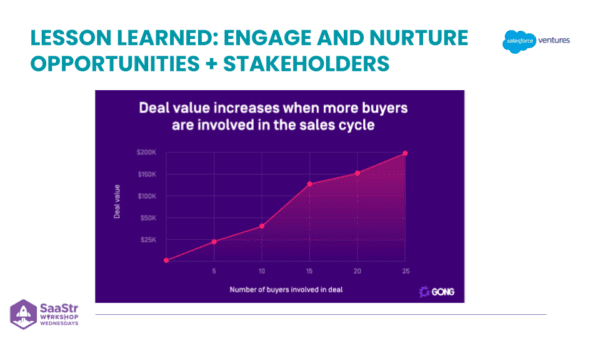
Another lesson learned from this challenge is you actually need to engage a lot more stakeholders. You always have to build more relationships within the customer organizations
Gong, as an example, started as an SMB platform and went to Enterprise. They discovered that the more buyers you involve in a deal all throughout the organization of a prospect, the greater the chances that the deal value increases.
Challenge #3: Making Your Product, Sales, and Marketing Organizations Enterprise-Ready
How do you actually get your entire organization aligned so they can support your Enterprise customers?
Salesforce Ventures had a conversation with Wiz and learned that it doesn’t work with the snap of your fingers if you have someone within your sales organization focusing on this. You need an integrated, holistic approach that starts with the CEO from the beginning. You also need dedicated resources across your organization — marketing, customer success, product, legal, and finance.
The lesson learned? You need to segment the entire organization, not just GTM. Specific features for Enterprise need to be top-of-mind and prioritized across the org.
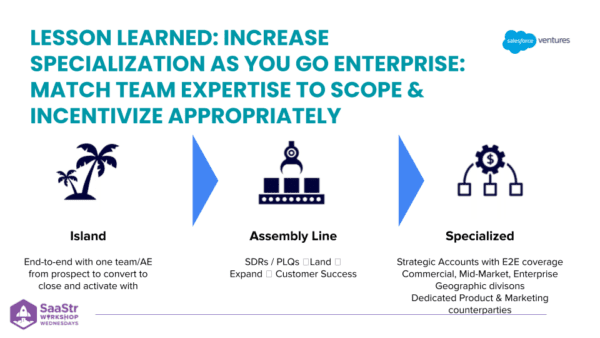
Another lesson learned during this challenge of alignment to become Enterprise-ready is to increase specialization as you go Enterprise. You want to match team expertise to the scope of the project and incentivize them appropriately. As you go through this upmarket evolution, you probably start out as an island, where you have one AE who closes some deals while working intensely with a founder or CEO in landing these initial deals.
As you grow bigger and start building out the organization, typically when you cross Series B+, you begin to specialize around Commercial, Mid-Market, and Enterprise.
Challenge #4: Marketing to Enterprise
Often, startups are disruptors in a space, so they first appear with playful, cheerful messaging to generate attention. That works great! But you come to a point when you start talking to CIOs, CTOs, and people in larger businesses, so you have to start thinking about the right messaging.
Gong is a good example. In the early days, their brand marketing was the left image. It’s playful and eye-catching. As the business grew and they started landing more Enterprise customers, they had to focus on being more strategic to their larger organization. It was no longer just a VP of Sales or Head of Sales. It’s a broader audience. In the image below, notice how their original branding is more fun, and playful, whilst the right-hand image shows their current messaging and how it’s more tailored to an Enterprise audience.
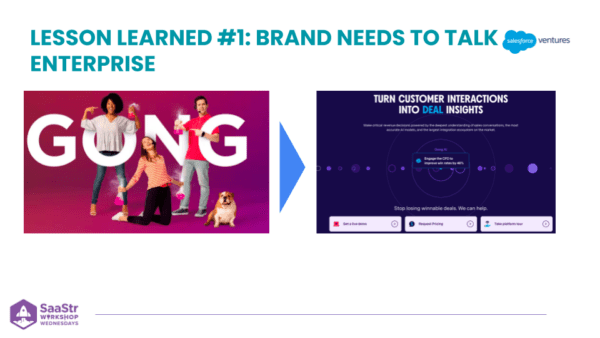
Another lesson learned: Marketing success is informed by sales success. Marketing works together with sales, and it’s really about the key metrics they should be tracking, like how much activity and MQLs lead to actual bookings and defining ways to track that activity. This is what your CMO needs to be focused on and keep iterating on as a measure of success and effectiveness.
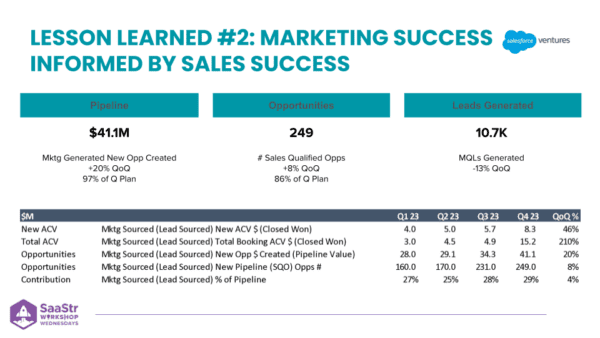
Challenge #5: Selling in Today’s Macro Environment
Today’s macro environment continues to be tough for many, but this year has been slightly better. The various sales leaders within the Salesforce Ventures portfolio don’t have full clarity on what 2024 will look like, but they feel good about it being better than it has been. How do you ensure you continue to sell successfully in today’s macro environment where people are looking to rationalize tools, talking about budgets and SaaS sprawl, and looking at cheaper solutions vs. best-in-class?
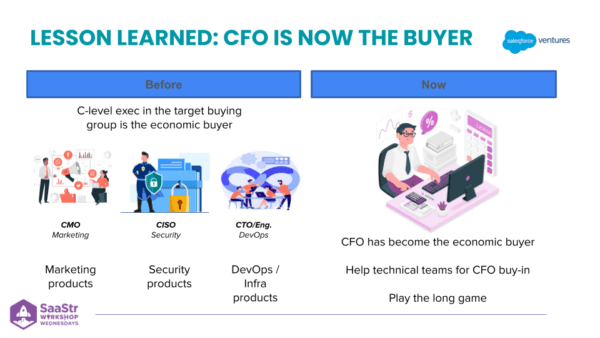
The lesson learned from industry leaders is that, besides the need to scope out all stakeholders, the CFO is central to any purchasing decision. You have to think about what the CFO values and shape your proposition to get the right message across to them. You should also consider helping the technical champion feel comfortable enough to help with CFO buy-in. Play the long game and find ways to get the deal across the line.
Key Takeaways
This shift from product-led to Enterprise takes longer and costs more upfront, but the outcome at the end of the journey is really good. So, get going, ask for advice, keep iterating, and trust the rewards will be there at the end.
The five key takeaways for those looking to move upmarket are:
- Show and deliver business value upfront.
- Get your sales organization aligned to go upmarket starting with the CEO.
- Integrate an Enterprise approach across the entire organization holistically.
- Tailor your messaging toward Enterprise as you grow.
- Shape your messaging around the needs and pains of the CFO.
The post 5 Challenges in Moving Upmarket and How to Overcome Them with Salesforce Ventures appeared first on SaaStr.
via https://www.aiupnow.com
Amelia Ibarra, Khareem Sudlow
